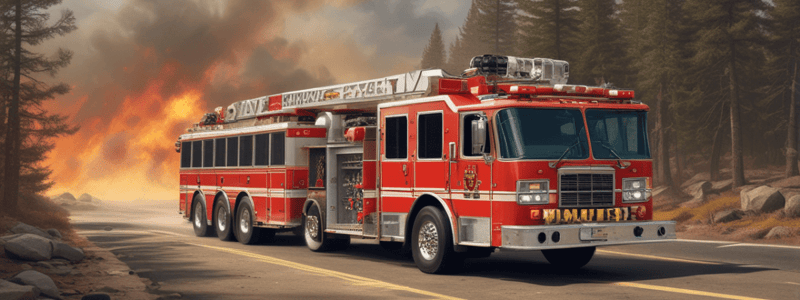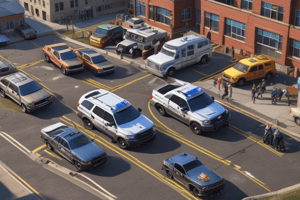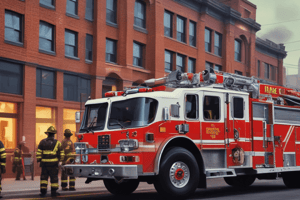Podcast
Questions and Answers
What does the Incident Action Plan (IAP) primarily provide in the context of incident management?
What does the Incident Action Plan (IAP) primarily provide in the context of incident management?
- A strict guideline for resource allocation
- An informal plan for managing volunteers
- A coherent means of communicating overall incident objectives (correct)
- A written communication of all incident activities
What is the recommended span of control for individuals with supervisory responsibility in incident management?
What is the recommended span of control for individuals with supervisory responsibility in incident management?
- 5-10 subordinates
- 2-5 subordinates
- 3-7 subordinates (correct)
- 1-3 subordinates
For operations lasting more than 12 hours, what should be considered according to IMS guidelines?
For operations lasting more than 12 hours, what should be considered according to IMS guidelines?
- No additional documentation is required
- A verbal IAP is adequate
- Only verbal updates are necessary
- A written IAP should be considered (correct)
What is a critical component of comprehensive resource management in IMS?
What is a critical component of comprehensive resource management in IMS?
What aspect of incident management does IMS emphasize for maintaining accountability?
What aspect of incident management does IMS emphasize for maintaining accountability?
Which of the following processes is included in resource management within IMS?
Which of the following processes is included in resource management within IMS?
What is an essential detail outlined in the principles of IMS for incident operations?
What is an essential detail outlined in the principles of IMS for incident operations?
What may occur if an IAP is not provided for incidents lasting longer than 12 hours?
What may occur if an IAP is not provided for incidents lasting longer than 12 hours?
What is the purpose of the Incident Management System (IMS) as described in the KCFD guidelines?
What is the purpose of the Incident Management System (IMS) as described in the KCFD guidelines?
Which of the following is a basic tenet of the Incident Management System?
Which of the following is a basic tenet of the Incident Management System?
In the context of KCFD guidelines, what is emphasized when establishing command during an incident?
In the context of KCFD guidelines, what is emphasized when establishing command during an incident?
What does KCFD suggest regarding mutual and automatic aid operations?
What does KCFD suggest regarding mutual and automatic aid operations?
What command options are outlined in the KCFD guidelines?
What command options are outlined in the KCFD guidelines?
According to KCFD, what is the recommended approach for transferring command during an incident?
According to KCFD, what is the recommended approach for transferring command during an incident?
In the KCFD Command Post guidelines, what is considered essential for effective operation?
In the KCFD Command Post guidelines, what is considered essential for effective operation?
Which factor is least likely to be considered when implementing the Incident Management System?
Which factor is least likely to be considered when implementing the Incident Management System?
What is the primary focus of Pumper 17 when establishing Linwood Command?
What is the primary focus of Pumper 17 when establishing Linwood Command?
Which command option involves immediate intervention by the company officer?
Which command option involves immediate intervention by the company officer?
What should be a top priority if a chief officer initiates Command without tactical capabilities?
What should be a top priority if a chief officer initiates Command without tactical capabilities?
In what scenario would the first-arriving company most likely assume Investigation Mode?
In what scenario would the first-arriving company most likely assume Investigation Mode?
What is the role of Medic 10 at a multi-vehicle accident scene?
What is the role of Medic 10 at a multi-vehicle accident scene?
What is the responsibility of responding companies during Investigation Mode?
What is the responsibility of responding companies during Investigation Mode?
What would prompt a Pumper company officer to shift to Fast Attack Mode?
What would prompt a Pumper company officer to shift to Fast Attack Mode?
Why might a company officer in a staff vehicle not establish full Command at a fire scene?
Why might a company officer in a staff vehicle not establish full Command at a fire scene?
What is one primary function of the Safety Officer in the incident command structure?
What is one primary function of the Safety Officer in the incident command structure?
Which position is responsible for managing the planning process within the incident command?
Which position is responsible for managing the planning process within the incident command?
What is the role of the Liaison Officer in the incident command system?
What is the role of the Liaison Officer in the incident command system?
Which position within the general staff is responsible for the allocation of resources?
Which position within the general staff is responsible for the allocation of resources?
What is the primary role of the Incident Commander?
What is the primary role of the Incident Commander?
Which section is specifically tasked with handling logistical needs in the incident command?
Which section is specifically tasked with handling logistical needs in the incident command?
Which unit leader within the Planning Section is specifically focused on documenting incident actions?
Which unit leader within the Planning Section is specifically focused on documenting incident actions?
In the command structure, who holds the responsibility of advising the Incident Commander?
In the command structure, who holds the responsibility of advising the Incident Commander?
What requirement must be met for interior crews when the company officer places them into action?
What requirement must be met for interior crews when the company officer places them into action?
Who usually assumes Command of the incident when a transfer of command occurs?
Who usually assumes Command of the incident when a transfer of command occurs?
What is required of the officer when assigning crew members to work under another company officer?
What is required of the officer when assigning crew members to work under another company officer?
What choice does a company officer have when assuming command?
What choice does a company officer have when assuming command?
What should later arriving, higher-ranking Chief Officers do upon arrival?
What should later arriving, higher-ranking Chief Officers do upon arrival?
What role does the acting company officer play when the company is placed into action?
What role does the acting company officer play when the company is placed into action?
What type of officer will typically assume command from a WOC captain during a transfer?
What type of officer will typically assume command from a WOC captain during a transfer?
What is primarily regulated by the collective and individual capabilities of the crew during action?
What is primarily regulated by the collective and individual capabilities of the crew during action?
Flashcards are hidden until you start studying
Study Notes
Introduction
- Incident Management System (IMS) is a structured approach used by KCFD for effective management of incidents.
- Aims to improve operational efficiency and ensure effective communication among responders.
KCFD Use of IMS
- KCFD implements IMS to enhance coordination and resource management during emergency incidents.
Basic Tenets of IMS
- Emphasizes unified command, effective accountability, and strategic resource management.
- Encourages the establishment of a clear Incident Action Plan (IAP) for communication of incident objectives.
Mutual and Automatic Aid Operations
- KCFD engages in mutual aid agreements for resource sharing and support during large-scale incidents.
General Concepts of Command
- Establishing command is a primary responsibility of the initial arriving unit at an incident scene.
- Command options available include Investigation Mode and Fast Attack Mode, dictating the officer's approach to managing the incident.
Command Options
- Investigation Mode: First unit investigates the scene and maintains command, with other units staging nearby.
- Fast Attack Mode: Immediate action is required to stabilize incidents; involves direct supervision by the incident commander.
KCFD Guidelines for Establishing Command
- Initial command is assumed by the first-arriving unit, usually led by a company officer.
- Command must be established swiftly to ensure organized incident management.
KCFD Guidelines for Transferring Command
- Command is transferred to the next higher-ranked officer upon arrival using established procedures.
- Generally, a captain or battalion chief will take over from a lower-ranking officer unless the incident is stabilized.
Command Post
- Establishment of a command post is crucial for effective incident management to centralize decision-making and communication.
Unified Command Incident
- Allows multiple agencies to work effectively together under a single command structure during multi-jurisdictional incidents.
Functional Responsibilities
- Clearly defined roles within the command structure ensure all responders understand their responsibilities, enhancing operational effectiveness.
- Important roles include Incident Commander, Safety Officer, Liaison Officer, and Public Information Officer.
Incident Commander
- Incident Commander is primary decision-maker during an incident and oversees operational dynamics.
Management by Objectives
- IMS relies on a clear IAP that communicates overall objectives throughout the incident response.
Span of Control
- Essential for effective management; optimal span of control is between three to seven subordinates for any supervisory role.
Resource Management
- Comprehensive resource management is integral, including tracking and accounting for resource utilization throughout the incident.
Accountability
- Maintains effective accountability of responders at all jurisdictional levels to ensure safety and operational integrity during incidents.
Studying That Suits You
Use AI to generate personalized quizzes and flashcards to suit your learning preferences.




